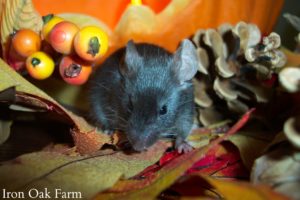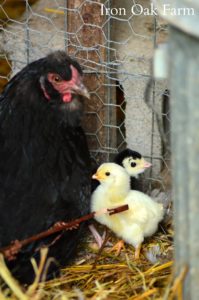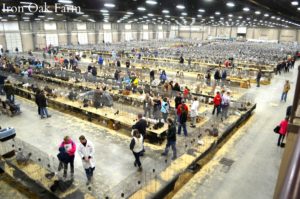 I recently attended a class at Michigan State University and became a Certified Salmonella Pullorum Tester. This certification allows me to test chicken flocks for Pullorum Typhoid which is required for NPIP certification.
I recently attended a class at Michigan State University and became a Certified Salmonella Pullorum Tester. This certification allows me to test chicken flocks for Pullorum Typhoid which is required for NPIP certification.
Over the next few posts I will take you through the experience and explain:
- What is Pullorum Typhoid and the NPIP
- How it effects you as a breeder, buyer-seller, 4-H member, someone who shows chickens, or someone who plans on shipping chickens or hatching eggs.
- How to test your flock/have your flock tested, what forms you need etc.
- How to become a Tester
What is Pullorum Typhoid Disease?
Pullorum Typhoid disease is a bacterial infection.
How do chickens get it?
 Pullorum is most often introduced by rodents. Flocks have a 1 in 10,000 chance of contracting the disease when there are no rodents present. The odds go up to 3 in 10,000 where rodents are allowed to mix with a flock. But it can also be introduced from wild birds.
Pullorum is most often introduced by rodents. Flocks have a 1 in 10,000 chance of contracting the disease when there are no rodents present. The odds go up to 3 in 10,000 where rodents are allowed to mix with a flock. But it can also be introduced from wild birds.
Chickens can spread it from contact with an infected bird, or from hen to chick.
 Pullorum is egg transferable, meaning the disease will often infect a hen’s reproductive organs and she will then transfer the bacteria to the offspring via the egg.
Pullorum is egg transferable, meaning the disease will often infect a hen’s reproductive organs and she will then transfer the bacteria to the offspring via the egg.
Symptoms
Most chickens who contract the disease will die, however, those who survive the illness will be lifetime carriers without showing any symptoms. This is why it’s important to test even seemingly healthy flocks. (More about this below)
Symptoms of an active infection include:
-white, pasty droppings, especially in chicks
-swelling in the joints
-lesions on internal organs
-dropping comb
-drowsiness
-lack of appetite
-drooping wings
-labored breathing
-stunted body
-high death rate in chicks 3 weeks after hatching
What is the NPIP?
NPIP stands for the National Poultry Improvement Plan.
“The National Poultry Improvement Plan was established in the early 1930’s to provide a cooperative industry, state, and federal program through which new diagnostic technology can be effectively applied to the improvement of poultry and poultry products throughout the country. The development of the NPIP was initiated to eliminate Pullorum Disease caused by Salmonella pullorum which was rampant in poultry and could cause upwards of 80% mortality in baby poultry. The program was later extended and refined to include testing and monitoring for Salmonella typhoid, Salmonella enteritidis, Mycoplasma gallisepticum, Mycoplasma synoviae, Mycoplasma meleagridis, and Avian Influenza. In addition, the NPIP currently includes commercial poultry, turkeys, waterfowl, exhibition poultry, backyard poultry, and game birds. The technical and management provisions of the NPIP have been developed jointly by Industry members and State and Federal officials. These criteria have established standards for the evaluation of poultry with respect to freedom from NPIP diseases.”
The NPIP is a voluntary, cooperative effort that has been able to all but eliminate Pullorum infections through testing and promoting biosecurity.
It involves the United States Department of Agriculture, the individual states, as well as the poultry industry.
As we learned in the certification class, Michigan has been Pollorum free since 1989 with the exception of 1 case in the Upper Peninsula 8 years ago. The source was never found, however, the case was isolated with no spread of the infection.
According to the NPIP Website, all states in the continental US are certified Pullorum-free with the exception of Idaho, Nevada, Wyoming, and Arizona.
So if my state is Pullorum free why do I need to be concerned with Pullorum?
 Small backyard breeders are growing rapidly, with the internet, trading chickens and mixing flocks have never been easier. Chicken show attendance is up which means large amounts of birds are coming in contact with each other from all over the country.
Small backyard breeders are growing rapidly, with the internet, trading chickens and mixing flocks have never been easier. Chicken show attendance is up which means large amounts of birds are coming in contact with each other from all over the country.
All of these situations increases the chance of the spread of infection and poses a threat to the large and small poultry industry. Luckily, there are standards that keep our chickens safe while at a show.
In my next post, I will explain the NPIP effects you as a breeder, buyer-seller, 4-H member, someone who shows chickens, or someone who plans on shipping chickens or hatching eggs.
For additional information, visit the NPIP website
Below is the video that they showed us in the class. I will reference it throughout this series.










